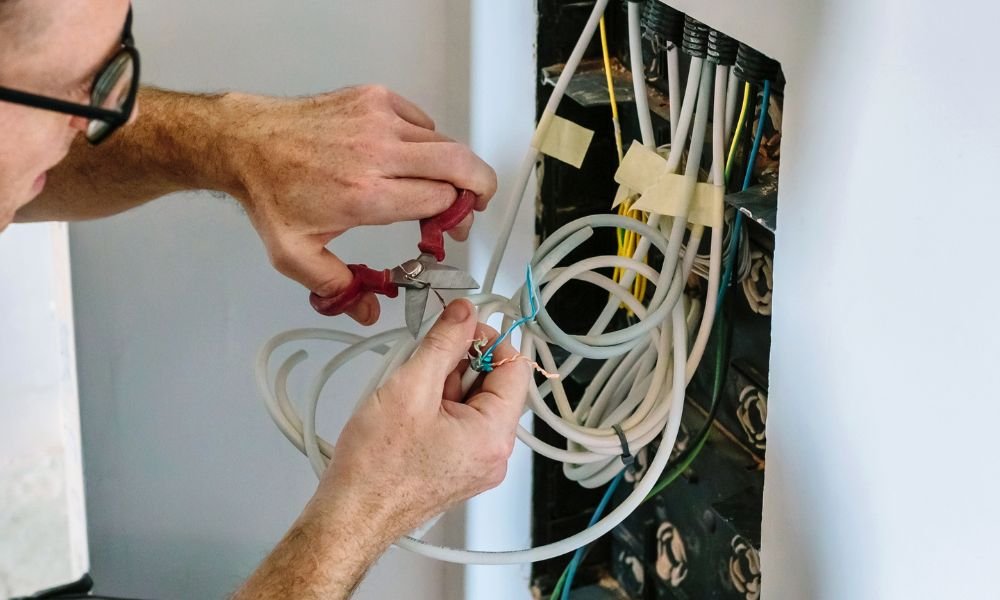In both business and residential settings, communications cabling serves as the essential infrastructure that enables seamless data and voice communication. It forms the backbone of our interconnected world, facilitating the exchange of information, access to the internet, and efficient communication between devices. In this post, readers can expect to gain a comprehensive understanding of communications cabling, including its various types such as Ethernet, fiber optic, and coaxial cables. They will learn about the advantages and best practices of structured cabling systems, the importance of professional installation, and how to troubleshoot common cabling issues. Additionally, the post will explore future trends in communications cabling, giving readers insights into the evolving landscape of connectivity.
Understanding Communications Cabling
What is Communications Cabling?
Definition: Communications cabling refers to the intricate network of cables and components that form the essential infrastructure supporting data and voice communication within a building, facility, or even across vast networks.
Role: Communications cabling acts as the vital bridge that connects various devices, enabling them to share information seamlessly. This includes connecting computers to the internet, facilitating phone conversations, and linking network equipment that powers our digital world.

Importance of Structured Cabling
Structured cabling is a well-organized and standardized approach to designing, installing, and managing cabling systems within a structure. Here, we explore why structured cabling is the cornerstone of efficient communication networks:
Concept of Structured Cabling: Structured cabling goes beyond mere cable installation. It encompasses a systematic and standardized approach to creating a unified cabling infrastructure that serves all communication needs within a building or facility. This approach involves careful planning, design, and documentation.
Benefits of Structured Cabling: The adoption of structured cabling brings forth a multitude of advantages:
- Scalability: Structured cabling systems are designed to accommodate future technological advancements and increased data demands. This scalability ensures that your cabling infrastructure can grow as your communication needs expand.
- Reliability: With structured cabling, you establish a dependable foundation for your communication network. It reduces the risk of connectivity issues, signal degradation, and downtime, ensuring uninterrupted operations.
- Ease of Maintenance: Structured cabling simplifies maintenance and troubleshooting. Its organized design makes it easier to identify and rectify any issues that may arise, reducing downtime and minimizing disruptions.
- Standardization: Structured cabling adheres to industry standards and practices, providing consistency and uniformity in cabling systems. This standardization simplifies installation, management, and future upgrades.
Structured cabling is not just a technical concept; it’s a strategic investment in the efficiency and reliability of your communication infrastructure. By adhering to structured cabling principles, businesses and homeowners can ensure that their networks remain robust, adaptable, and capable of meeting the ever-evolving demands of modern communication.

Types of Communications Cabling
Ethernet Cabling
Ethernet cables are the workhorses of modern networking, and they come in various categories, each tailored for specific needs:
- Cat5e (Category 5e): Cat5e cables are a reliable choice for standard networking needs. They offer decent data transfer rates and are suitable for most home and small office applications. They are a cost-effective and practical option for connecting computers, printers, and other devices.
- Cat6 (Category 6): Stepping up the performance, Cat6 cables offer higher bandwidth and better shielding than Cat5e. They are ideal for applications that require increased data transfer rates and reduced interference. Cat6 is commonly used in businesses and homes with demanding network requirements.
- Cat7 (Category 7): Cat7 cables are the cream of the crop in Ethernet performance. They deliver top-tier data transfer rates and superior shielding, making them the go-to choice for applications demanding the utmost performance and reliability. Cat7 is suitable for data centers, businesses with high-speed networking needs, and advanced home networks.
Fiber Optic Cabling
Fiber optic cables revolutionize data transmission through their use of light signals. They offer several advantages:
- High-Speed Data Transmission: Fiber optic cables transmit data at incredibly high speeds, making them ideal for applications requiring rapid data transfer, such as high-speed internet and data centers.
- Immunity to Interference: Fiber optics are immune to electromagnetic interference, ensuring signal integrity even in electrically noisy environments. This makes them highly reliable for critical data transmission.

Coaxial Cabling
Coaxial cables are known for their durability and are widely used in television and broadband communication:
- Structure: Coaxial cables consist of a central conductor, an insulating layer, shielding, and an outer jacket. This design provides both electrical and physical protection for the transmitted signals.
- Applications: Coaxial cables have a rich history in cable television and are still crucial for delivering cable television and broadband internet to homes and businesses.
- Durability: Coaxial cables are highly durable and can withstand environmental conditions, making them suitable for outdoor and indoor installations.
- Resistance to Interference: Coaxial cables are resistant to electromagnetic interference, ensuring stable signal transmission.
Installation and Best Practices
In this section, we will explore the critical aspects of installing communications cabling, emphasizing the importance of planning and considering professional installation when necessary.
Planning Communications Cabling
Importance of Planning:
Before you embark on the installation of communications cabling, meticulous planning is essential. Here’s why:
- Efficiency: Planning ensures that your cabling system is efficient and tailored to your specific needs. It prevents over-engineering or under-provisioning.
- Cost-Efficiency: Proper planning helps you avoid unnecessary costs by ensuring you purchase the right cables, connectors, and accessories.
Assessing Needs:
- Identify Requirements: Assess your communication needs thoroughly. Determine the types of devices you’ll connect, the required data transfer rates, and any special requirements.
- Future-Proofing: Consider future growth and technological advancements when planning. A well-planned cabling system should accommodate future changes with minimal disruption.
Cable Routing:
- Choosing the Right Path: Plan the physical routes for your cables carefully. Avoid areas prone to interference or damage, and ensure cables are not subjected to excessive bending or tension.
- Avoiding Interference: Keep cables away from sources of electromagnetic interference, such as power lines and electronic equipment.

Professional vs. DIY Installation
Advantages of Professional Installation:
- Expertise: Professional installers have the expertise to design and implement cabling systems that meet industry standards and best practices. They ensure optimal performance and reliability.
- Compliance: Professionals are well-versed in local regulations and codes, ensuring that your installation is compliant with safety and quality standards.
- Efficiency: Professional installations are efficient and well-documented, making it easier to manage and maintain your cabling infrastructure over time.
DIY Installation Tips:
For smaller-scale projects, you may consider DIY installation. Here are some tips to ensure a safe and effective installation:
- Safety First: Prioritize safety. Use appropriate safety gear and tools, and follow safety guidelines when working with cabling.
- Research and Education: Educate yourself about cabling standards and best practices. Follow manufacturer guidelines for cable installation.
- Testing: Invest in cable testing tools to verify the integrity of your connections and identify any issues.
- Labeling: Properly label cables and connections for easy identification and troubleshooting.

If you’re planning to upgrade your communications cabling or if you want to ensure that your existing cabling is performing at its best, we recommend reaching out to professionals. They can assess your needs, design a tailored cabling solution, and execute the installation with precision. Don’t compromise on the quality and reliability of your communication networks. Prioritize structured cabling and seek professional assistance to ensure that your data and voice communication systems are efficient and dependable, meeting the demands of the digital age.

